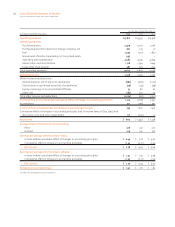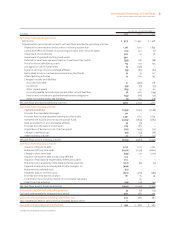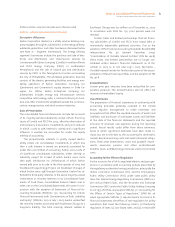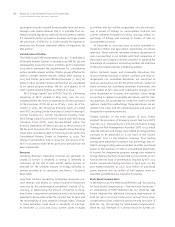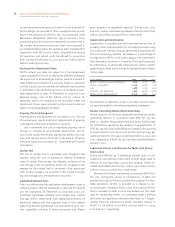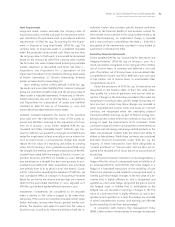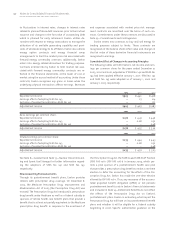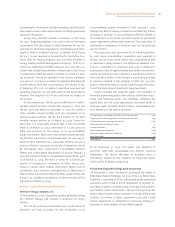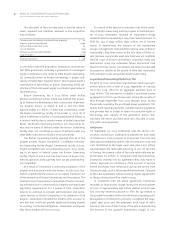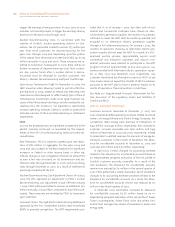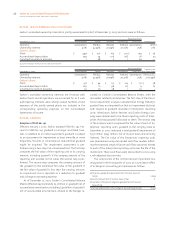ComEd 2003 Annual Report Download - page 90
Download and view the complete annual report
Please find page 90 of the 2003 ComEd annual report below. You can navigate through the pages in the report by either clicking on the pages listed below, or by using the keyword search tool below to find specific information within the annual report.
88 Notes to Consolidated Financial Statements
EXELON CORPORATION AND SUBSIDIARY COMPANIES
nuclear decommissioning trust funds for units acquired af-
ter the Merger are reported in other comprehensive income.
Prior to the adoption of SFAS No. 143, “Accounting for Asset
Retirement Obligations” (SFAS No. 143) on January 1, 2003,
unrealized gains and losses on marketable securities held in
the nuclear decommissioning trust funds were reported in
accumulated depreciation for operating units transferred to
Generation from PECO and as other comprehensive income
for operating and retired units transferred to Generation
from ComEd. At December 31, 2003 and 2002, Exelon had no
held-to-maturity securities.
Purchased Gas Adjustment Clause
PECO’s natural gas rates are subject to a fuel adjustment
clause designed to recover or refund the difference between
the actual cost of purchased gas and the amount included in
rates. Differences between the amounts billed to customers
and the actual costs recoverable are deferred and recovered
or refunded in future periods by means of prospective quar-
terly adjustments to rates. At December 31, 2003 and 2002,
deferred energy costs of $81 million and $31 million, re-
spectively, which are expected to be recovered under the
adjustment clause, were recorded in other current assets on
Exelon’s Consolidated Balance Sheets.
Property, Plant and Equipment
Property, plant and equipment is recorded at cost. The cost
of maintenance, repairs and minor replacements of property
is charged to maintenance expense as incurred.
Upon retirement, the cost of regulated property, net of
salvage, is charged to accumulated depreciation and re-
moval costs reduce the related regulatory liability in accord-
ance with the provisions of SFAS No. 71. See Note 6 – Property,
Plant and Equipment and Note 20 – Supplemental Financial
Information.
Nuclear Fuel
The cost of nuclear fuel is capitalized and charged to fuel
expense using the unit of production method. Estimated
costs of nuclear fuel storage and disposal, exclusive of dry
cask storage costs, at operating plants are charged to fuel
expense as the related fuel is consumed. Costs associated
with nuclear outages are recorded in the period incurred.
Dry cask storage costs are expensed as incurred.
Capitalized Software Costs
Costs incurred during the application development stage of
software projects that are developed or obtained for internal
use are capitalized. At December 31, 2003 and 2002, un-
amortized capitalized software costs totaled $630 million
and $491 million, respectively. Such capitalized amounts are
amortized ratably over the expected lives of the projects
when they become operational, not to exceed ten years. Cer-
tain capitalized software is being amortized over fifteen
years pursuant to regulatory approval. During 2003, 2002
and 2001, Exelon amortized capitalized software costs of $69
million, $64 million and $39 million, respectively.
Depreciation and Amortization
Depreciation is provided over the estimated service lives of
property, plant and equipment on a straight-line basis using
the composite method. Annual depreciation provisions for
financial reporting purposes, expressed as a percentage of
average service life for each asset category, are presented in
the table below. See Note 6 – Property, Plant and Equipment
for information on service life extensions for certain nuclear
generating stations and a change in Energy Delivery’s depre-
ciation rates.
Asset Category 2003 2002 2001
Electric – transmission and distribution 2.81% 3.11% 3.97%
Electric – generation 2.90% 3.65% 3.11%
Gas 2.38% 2.13% 2.34%
Common – gas and electric 7.53% 6.40% 6.26%
Other property and equipment 8.20% 7.88% 9.53%
Amortization of regulatory assets is provided over the recov-
ery period specified in the related regulatory agreement.
Nuclear Generating Station Decommissioning
Exelon accounts for the costs of decommissioning its nuclear
generating stations in accordance with SFAS No. 143. See
Note 13 – Nuclear Decommissioning and Spent Fuel Storage
for information regarding the adoption and application of
SFAS No. 143 and Cumulative Effect of Changes in Accounting
Principle below for pro forma net income and earnings per
common share for the years ended December 31, 2002 and
2001, adjusted as if SFAS No. 143 had been applied effective
January 1, 2001.
Capitalized Interest and Allowance for Funds Used During
Construction
Exelon uses SFAS No. 34, “Capitalizing Interest Costs,” to cal-
culate the costs during construction of debt funds used to
finance its non-regulated construction projects. Exelon re-
corded capitalized interest of $15 million, $20 million and $17
million in 2003, 2002 and 2001, respectively.
Allowance for funds used during construction (AFUDC) is
the cost, during the period of construction, of debt and
equity funds used to finance construction projects for regu-
lated operations. AFUDC is recorded as a charge to con-
struction work in progress and as a non-cash credit to AFUDC
that is included in other income and deductions. The rates
used for capitalizing AFUDC are computed under a method
prescribed by regulatory authorities (see Note 20 – Supple-
mental Financial Information). Exelon recorded charges to
AFUDC of $16 million, $19 million and $19 million in 2003,
2002 and 2001, respectively.




